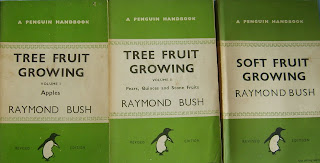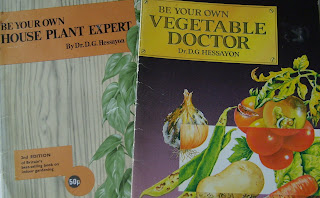
I'm honoured and grateful to be able to post this wonderful piece by the writer Sarah Salway
My Mother, a storytelling gardener
Sarah Salway
(In 1979, my mother, Elizabeth Peplow published her first book about herbs, Herbs, Country Crafts (Hamlyn, 1979). This was followed by Stay Slim with Herbs & Spices (Darton, Longman & Todd, 1981), The Herb Book, An A-Z of Useful Plants (W H Allen, 1982), Herb & Herb Gardens of Britain (Webb & Bower, 1984) and In A Monastery Garden (David & Charles, 1988). During this time, she also designed herb gardens for English cathedrals, including Peterborough and Wells, as well as the physic gardens at Westminster Abbey and Castle Acre Priory. When the Garden Monkey suggested I write something about Mum and her work, I think s/he was thinking I might come up with a few paragraphs, but in writing this piece, I found myself going on and on in a way my mother would have definitely called ‘pure indulgence’. Looking at the list of her books above though, and as a writer and mother myself, I’m amazed at how she managed to be so productive. Four children, five books, and even more gardens. I’m ashamed to say I’d never put her books together in a pile before but it shocked me because, when we were growing up, she never made it feel like she was working, perhaps because she loved what she did so much. Anyway, writing this piece of ‘pure indulgence’ has been a chance to acknowledge her work as an author, rather than just mother.)
Even before she started writing books about herbs and gardens, my mother had designed and planted her garden in the shape of narratives.
Herbs were best for her particular style of story-telling and if she had a favourite, it was simple parsley. ‘You really cannot use too much of it,’ she writes, ‘and I have yet to meet anybody who dislikes the taste.’
You could stand in front of one parsley plant for hours as my mother would talk about the myths – that it never grew in any house where the woman wore the trousers; the folklore – that it is so slow to germinate because the roots have to go nine times down to the devil before the seedlings can break surface; the recipes – with broad beans, with lemon juice; the benefits – digestive, clarity of mind, or even to add lustre to your hair.
Of course, back then, I longed for her to be normal and buy her parsley dried and tasting of cardboard in those little packets you got from the supermarket – just like everybody else’s mother.
This was the late 1970s, before herbs were as universal as they are now. When my parents opened a small herb farm on the edge of Cambridgeshire, growing and using them was still treated as suspicious. Neither had any formal gardening training but they’d been sharing dreams ever since they first met at a creative writing conference. As children, it was the other kids with fathers and mothers who went out every morning to work in an office that were the odd ones. We learnt that the two traits you had to avoid at all costs were routine and boredom. Our parents’ mantra could have been, why not try it? So, with the herb farm, it was very much a case of learning as they grew, not least in dealing with customers.
One day, a clipping in a national paper about how feverfew could cure migraines caused a period of surreal chaos. A particular buyer didn’t even turn off his car engine as he rushed over to grab a pot of feverfew. He’d driven off before my mother could begin to tell her stories about the plant’s history, and how to use it.
It felt like we had just sold him a spell. He needed us, but he certainly didn’t want to get too close. The whole witch thing wasn’t helped by the fact our house was called The Hoo and there were gravestones in our front garden, cared for by a seventy year old handyman who often wore a black leather flying cap.
About this time, my mother wrote and published her first book.
This was a mother who once sent me and my sister off shopping with a list that read ‘Nutty nuts’, ‘apply apples’ and ‘peachy peaches’, and so on for every food item we needed. I was too young to read myself, so I didn’t understand why the shopkeeper was so confused but it took a long time for my sister to forgive Mum.
Admittedly in her books she didn’t exactly write ‘herby herbs’ but her sense of humour still comes across on the printed page. My mother wrote as she talked. Even picking up one of her books now, ‘The Herb Book, an A-Z of Useful Plants’, more than twenty years after she first published it, I can hear her voice, steamrolling over any possible objection.
… even the smallest of backyards can be transformed into a
fairy-tale herb garden with sweetly scented roses climbing up
the wall and cushions of low-growing thyme and chamomile
spilling over the gaps between the paving stones.
If anything, the secret to Mum’s passion is in that word, ‘useful’, in the book’s title. She was a fen farmer’s daughter through and through, and she loved herbs because they had never – unlike exotic fruits or other expensive plant specimens – belonged solely to the aristocracy. ‘Herbs are somewhat humbler than the spices,’ she writes with approval. When she was researching into the history of herbs, she was studying what she might herself have used in different periods through out history. Ordinary people were always what interested her most.
In the novel I’m writing at the moment, my narrator is renovating an historic garden. This is how she explains her job:
Although I design historic gardens for a living, my work is never just about the past. The plans for most of the gardens I work on were first created hundreds of years ago. The gardener could have no idea how his garden would look like when it reached maturity so what I have to do is to put myself in his shoes and try to capture what he can only have imagined. In some ways, I have to dream someone else’s dreams for them.
I’m sure this was how Mum approached her herb garden designs. Although she was a stickler for historical accuracy and would spend hours in libraries and the Cathedral’s own records, she never saw herself as creating a museum piece because the plants and their stories were so completely in the present for her.
Gardeny gardens. Booky books. But always with the mission to entertain. The last thing my mother would have wanted was to have been called an expert, and especially not an intellectual. She was in awe of those around her whom she considered the real expert gardeners, including Rosemary Verey, Beth Chatto, Christopher Lloyd, Penelope Hobhouse. She would tell us about meeting them as if they were rock stars, seeing herself just as someone who loved stories, and she carried on reading and writing because she liked nothing better than to hear new ones.
It makes me smile now to turn to the introduction to one of the two books she wrote with my father, and see these lines the introduction:
If, on a warm afternoon in the summer of 1537, you had chanced to be at a certain country fair in the Cotswolds, you might have observed an authoritative but cheerful monk in a black habit talking briskly with a seller of agricultural sundries. You would have been struck, perhaps, by his eagerness to examine every item on display and to extract from the vendor every available morsel of information, news and advice. You may have smiled, as those about you would have done, when the vendor, weary of the barrage of questions, pushed a tiny pouch of seeds into the hands of his friendly but troublesome inquisitor and bade him take his enquiries elsewhere.
Although Mum was writing here about the monk-gardener Stephen, she could have been writing about herself. Her first job was as assistant to the women’s editor of Farmers Weekly and it left her with an ability to get people to tell her things. If stories came first, then people were a close second.
She’d come back from her research trips to gardens round the country for both In A Monastery Garden and her guidebook, Herbs and Herb Gardens, A Complete Guide, wishing she could write another book just about the new friends she’d met. Her favourite was the scruffy looking gardener who spent the morning showing her round one garden before she discovered – of course - that he was the titled owner. But there were plenty of others too, the more eccentric the better, and when she and Dad turned part of our garden into a series of Elizabethan-style herb gardens, they came to our home too. Far too many to count who only wanted to talk about herbs, herbs, herbs.
After we all left home, Mum continued to research, design and publish. It’s hard, I think, for children to admit their mothers may actually know anything interesting, but there always comes a time – often sudden and shocking – when we see them as a person in their own right.
For me, it took a Valentine’s card. For years, she’d made us all our own cards every 14th February with sprigs of dried herbs that had special meanings just for us. One year, she made an extra one and sent it to her main publishing love, the magazine, Amateur Gardening and its then deputy editor, Alan Titchmarsh.
Interestingly, it was Mum who was embarrassed when they photographed and printed the card as a cover story. The rest of the family thought it was funny because sending a love token to a gardening magazine summed up everything about her, and what she had become.
Yes, she was still the strange woman, often wearing mismatched Wellington boots, who had a habit of lurking in the garden and jumping out at my friends from behind a bush for a joke, and she was also definitely still the recluse who would hide in the library, pretending she hadn’t heard me calling so she could have a few more minutes with her books, but her commitment to sharing her passion for herbs through gardening, teaching and above all, writing, was something I could be proud of.
Mum died in 2003, and now, of course, books about herbs are everywhere. It’s hard to remember how groundbreaking Mum’s work seemed at the time. Some of the resistance she came across is acknowledged in this one sentence from Stay Slim with Herbs & Spices:
A few years ago we found it difficult to persuade any of our students even to try herb teas without grimacing and muttering ‘not for me’ or ‘dishwater’. But times are changing.
Changing times indeed. Writing about herb gardening was a way for my mother to let other people enjoy her excitement about traveling through time. It’s a trait shared by many of the gardeners and gardening writers she respected. By showing us how to look closely at a small parsley plant, for example - by really taking in every detail and seeing how it had been used and still could be – they allow us to see a much bigger story about ordinary extraordinary people.
The sort of stories she always loved best.
.























